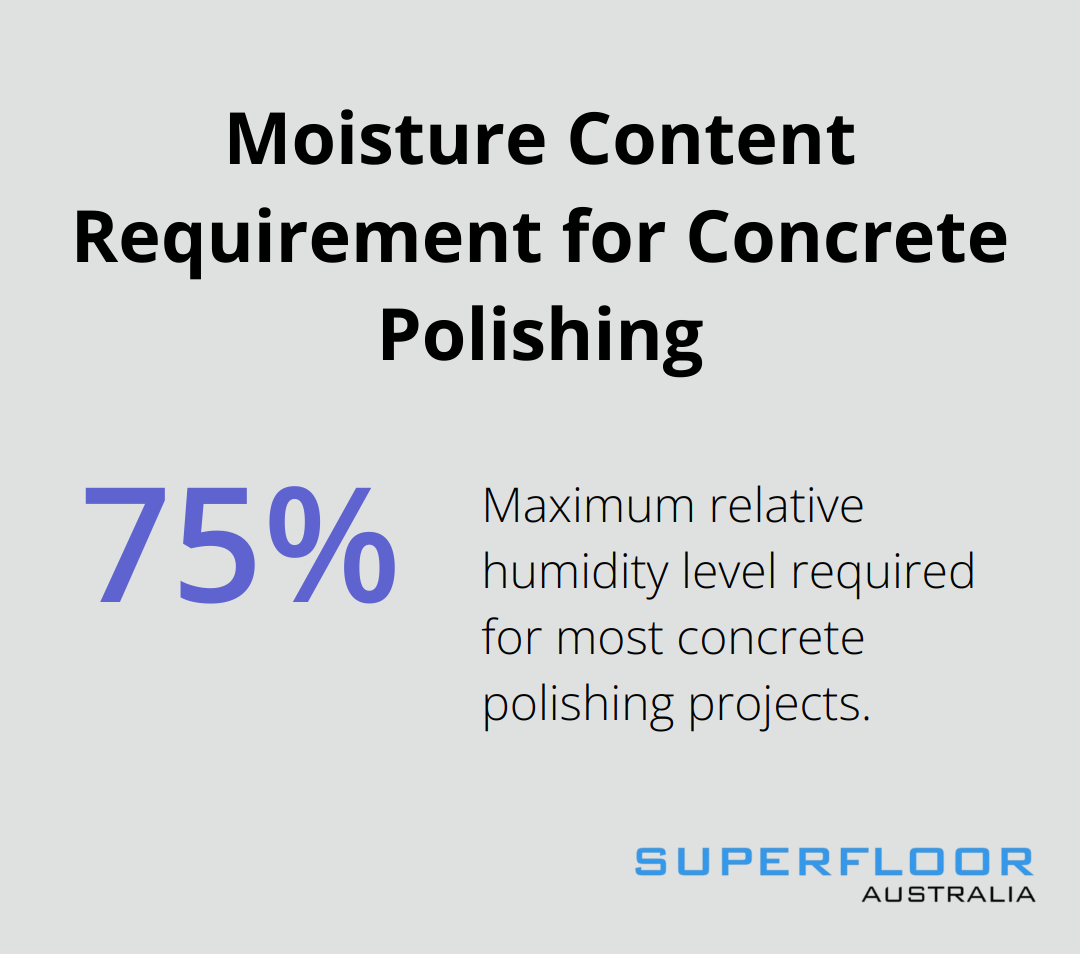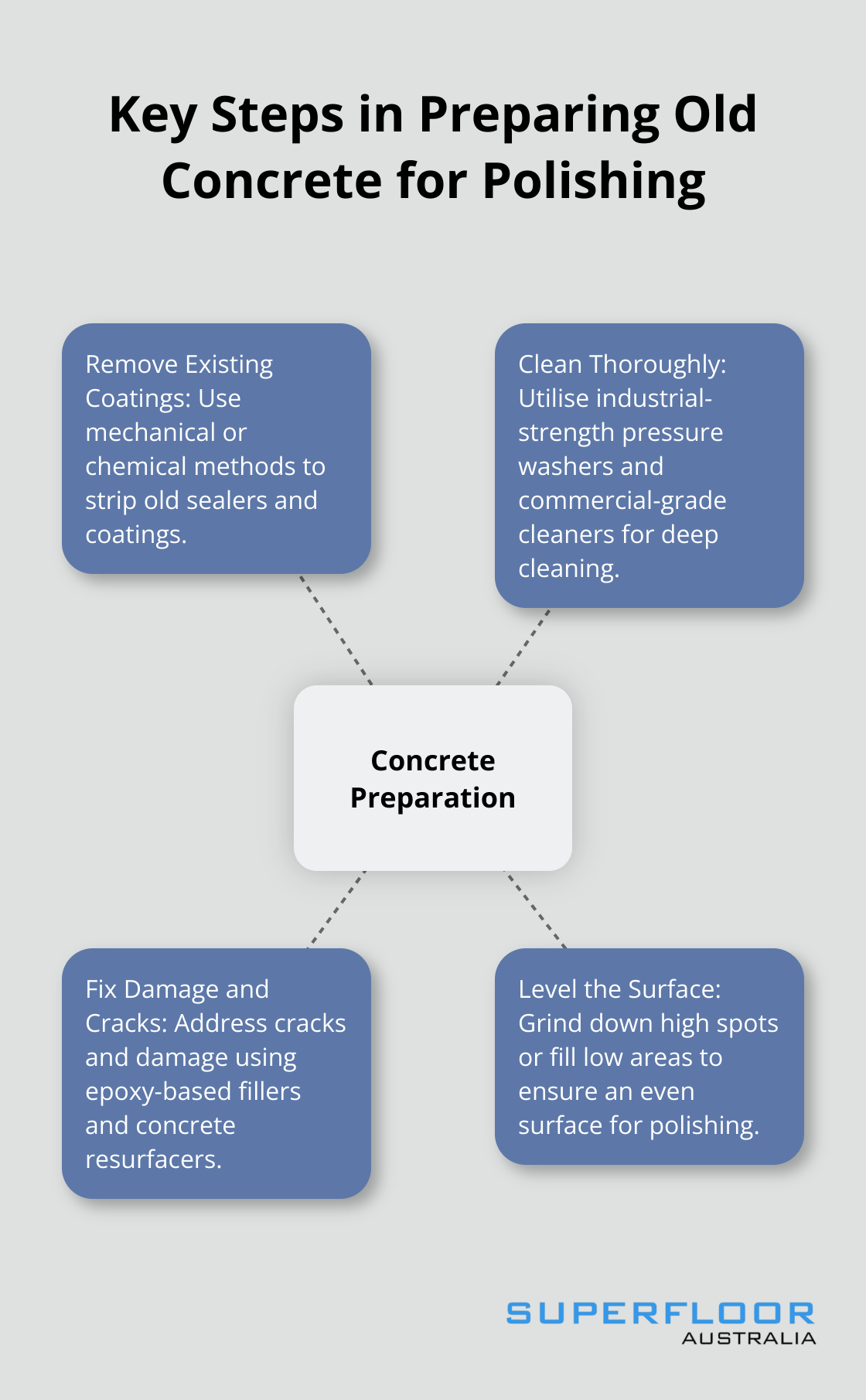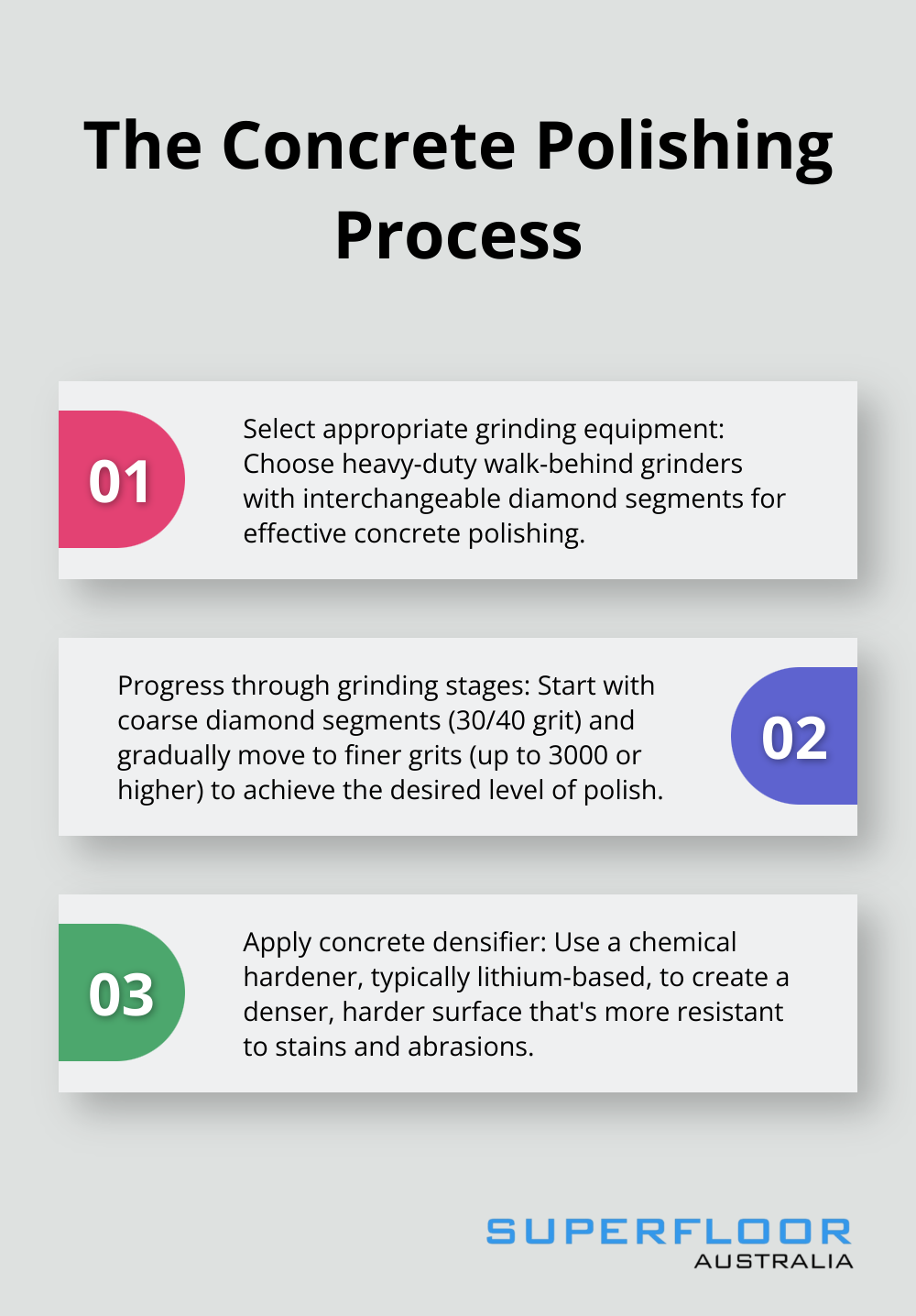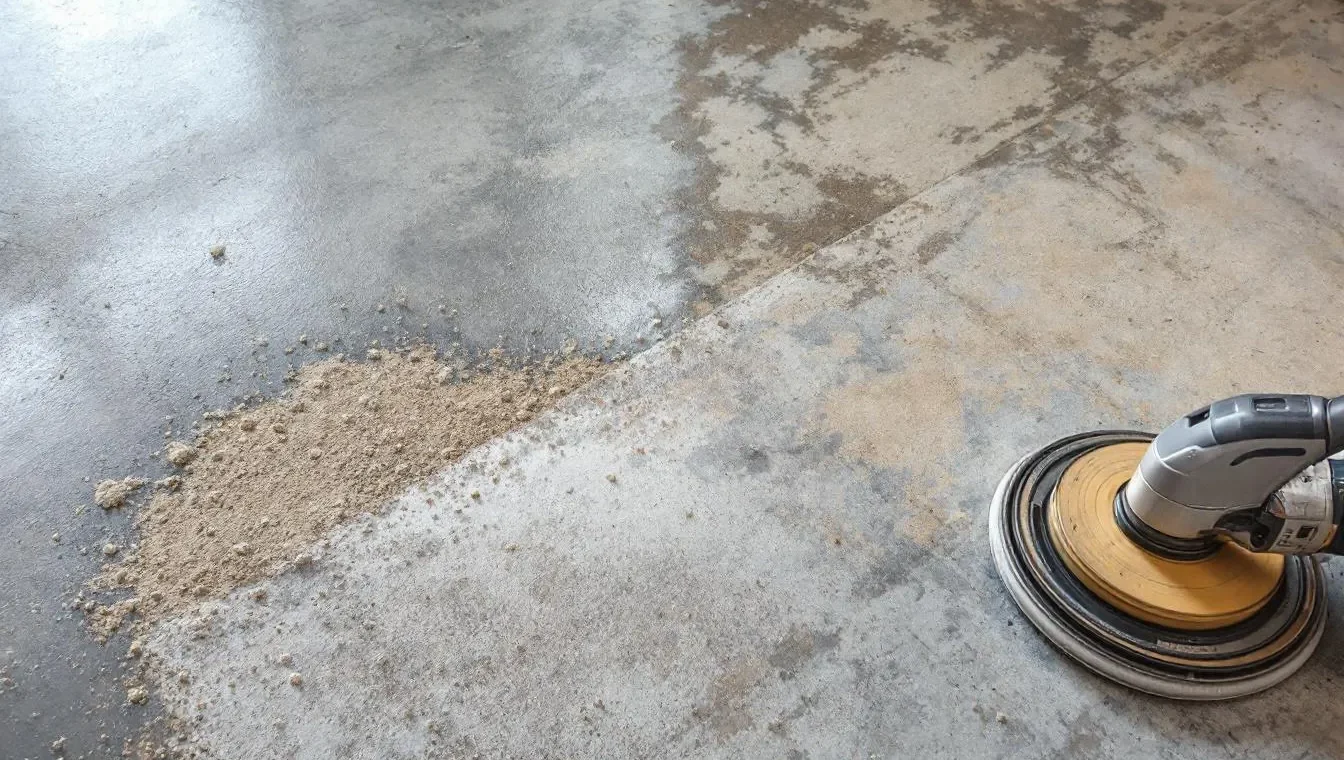At Superfloor Australia, we know that polishing old concrete floors can transform worn-out surfaces into stunning, modern spaces.
Many homeowners and businesses overlook the potential of their existing concrete floors, assuming they need to be replaced entirely.
This guide will show you how to breathe new life into your old concrete, creating a fresh, durable, and low-maintenance flooring solution.
What’s Your Floor’s Current State?
At Superfloor Australia, we’ve witnessed the transformation of numerous old concrete floors into stunning surfaces. The first step in this process always involves a thorough assessment. Here’s how to evaluate your floor’s condition effectively:
Visual Inspection
Examine your floor closely. Look for obvious signs of wear and tear, such as small cracks, chips, or surface spalling. Concrete repair is ideal for these localised issues. Note any areas where the concrete appears uneven or has noticeable dips. These issues need addressing before polishing can begin.
Crack Analysis
Not all cracks are equal. Hairline cracks (less than 1/8 inch wide) are usually cosmetic and can often be filled during the polishing process. Larger cracks may indicate structural issues and might require professional repair before polishing. The American Concrete Institute suggests that cracks wider than 1/4 inch should be evaluated by a structural engineer.
Moisture Testing
Excess moisture can ruin polished concrete. Use a moisture meter to check the floor’s moisture content. According to ASTM standards, when testing via ASTM F2170, the RH level of a concrete slab needs to be at or below 75% for most polishing projects.

Stain Assessment
Identify any stains on your floor. Oil, grease, paint, or rust stains may require special treatment. Some stains might be impossible to remove completely, but they can often be minimised during the polishing process. Document these areas for reference.
Hardness Test
The hardness of your concrete affects the polishing process. Use a simple scratch test: if a copper penny can scratch the surface, your concrete might be too soft for standard polishing. In this case, you might need to apply a hardener before polishing.
Previous treatments also play a role in the assessment. Determine if your floor has any existing sealers or coatings. These will need to be removed before polishing can begin. A water drop test can help assess porosity; if water beads up, the surface may need additional preparation.
This thorough assessment of your old concrete floor will provide a clear picture of what needs to be done before polishing can begin. Now that you’ve evaluated your floor’s condition, it’s time to move on to the next crucial step: preparing the concrete surface for polishing.
How to Prepare Old Concrete for Polishing
At Superfloor Australia, we’ve refined our concrete preparation process to ensure the best possible outcome for polishing old floors. This essential step sets the foundation for a successful transformation.

Remove Existing Coatings
The first task involves the removal of any existing coatings or sealers. We decide between mechanical or chemical removal. Mechanical removal includes grinding, scraping, and shot blasting. It’s effective for thicker coatings. For stubborn coatings, we often employ a combination of chemical and mechanical removal.
Clean Thoroughly
After the old coatings are gone, we clean the floor extensively. This isn’t just a quick sweep – we utilise industrial-strength pressure washers and commercial-grade cleaners that can save time and effort. For particularly stubborn stains, we might apply specialised cleaning agents or even perform light grinding.
Fix Damage and Cracks
We address any cracks or damage next. Epoxy-based crack fillers are very effective when it comes to fixing cracks in concrete floors. We ensure that the crack we’re trying to fix can be properly filled before proceeding.
Spalling or pitting is another common issue with old concrete. We often use a concrete resurfacer to even out these areas. This product is trowelled on and creates a smooth, new surface that’s ready for polishing.
Level the Surface
The final preparation step tackles any unevenness in the floor. This might involve grinding down high spots or filling low areas with a self-levelling compound. A level floor is vital for achieving an even polish and preventing issues like pooling water.
This preparation phase takes time but is absolutely necessary. Rushing through these steps can lead to poor results and a shorter lifespan for your polished concrete floor. (We’ve seen firsthand how thorough preparation leads to stunning, long-lasting results.)
With the floor now properly prepared, it’s time to move on to the actual polishing process. The next section will detail how we transform your old concrete floor and reveal its hidden beauty through our expert polishing techniques.
How We Polish Old Concrete Floors
Selecting the Right Equipment
We start by choosing the appropriate grinding equipment. For most old concrete floors, we select a heavy-duty walk-behind grinder with interchangeable diamond segments. These machines are ideal for coating removal, creating non-slip surfaces, floor preparation, and road maintenance.

The Grinding Process
Our initial pass uses coarse diamond segments, usually 30/40 grit. This aggressive grinding removes major imperfections and opens up the concrete’s pores. We then progress through medium grits (80, 150) to finer grits (300, 800). Each pass refines the surface further, gradually closing the concrete’s pores.
We pay close attention to edges and corners. We use specialised edge grinders to ensure these areas receive the same level of polish as the main floor area.
Applying Concrete Densifier
After the initial grinding stages, we apply a chemical hardener, or densifier. This liquid penetrates the concrete, reacts with free lime to create a denser, harder surface. We typically use lithium-based densifiers as they offer excellent penetration and greater strengthening of the floor surface.
The densifier application is important. It not only hardens the surface but also helps achieve a higher polish and increases the floor’s resistance to stains and abrasions. We allow the densifier to cure for at least 24 hours before we proceed.
Achieving the Desired Shine
The final polishing stage transforms the concrete. We use ultra-fine diamond abrasives to bring out the full shine of the concrete. The exact grit sequence depends on the desired level of shine and the hardness of the concrete.
For a matte finish, we might stop at 400 grit. For a high-gloss mirror finish, we continue to 3000 grit or higher. Each pass with a finer grit increases the floor’s reflectivity and smoothness.
Throughout this process, we use dust extraction systems to minimise airborne particles, ensuring a clean work environment and a better final result.
The entire polishing process for an average-sized room (about 40 square metres) typically takes 2-3 days. Larger areas or floors that require extensive repair may take longer.
After polishing, we apply a stain guard to enhance the floor’s resistance to spills and stains. This final step helps maintain the polished look for longer periods between maintenance polishing.
Properly polished concrete floors can last 20 to 30 years or more with minimal maintenance in residential settings, making them a cost-effective and durable flooring solution for both residential and commercial spaces.
Final Thoughts
Polishing old concrete floors transforms worn surfaces into sleek, stunning spaces. We at Superfloor Australia have witnessed countless floors undergo this remarkable change. The process involves thorough assessment, meticulous preparation, and progressive grinding with diamond abrasives to achieve the desired sheen.
Polished concrete floors offer numerous benefits. They resist stains, dust, and allergens, making them ideal for both homes and businesses. The reflective surface brightens rooms and can potentially reduce lighting costs. These eco-friendly floors utilise existing materials and often last decades with minimal upkeep.
For those in Brisbane seeking to revitalise their old concrete floors, Superfloor Australia offers expert polishing services. Our team’s precision ensures lasting results that enhance both aesthetics and functionality. Polishing old concrete floors combines beauty, durability, and low maintenance (making it a smart investment for any space).
